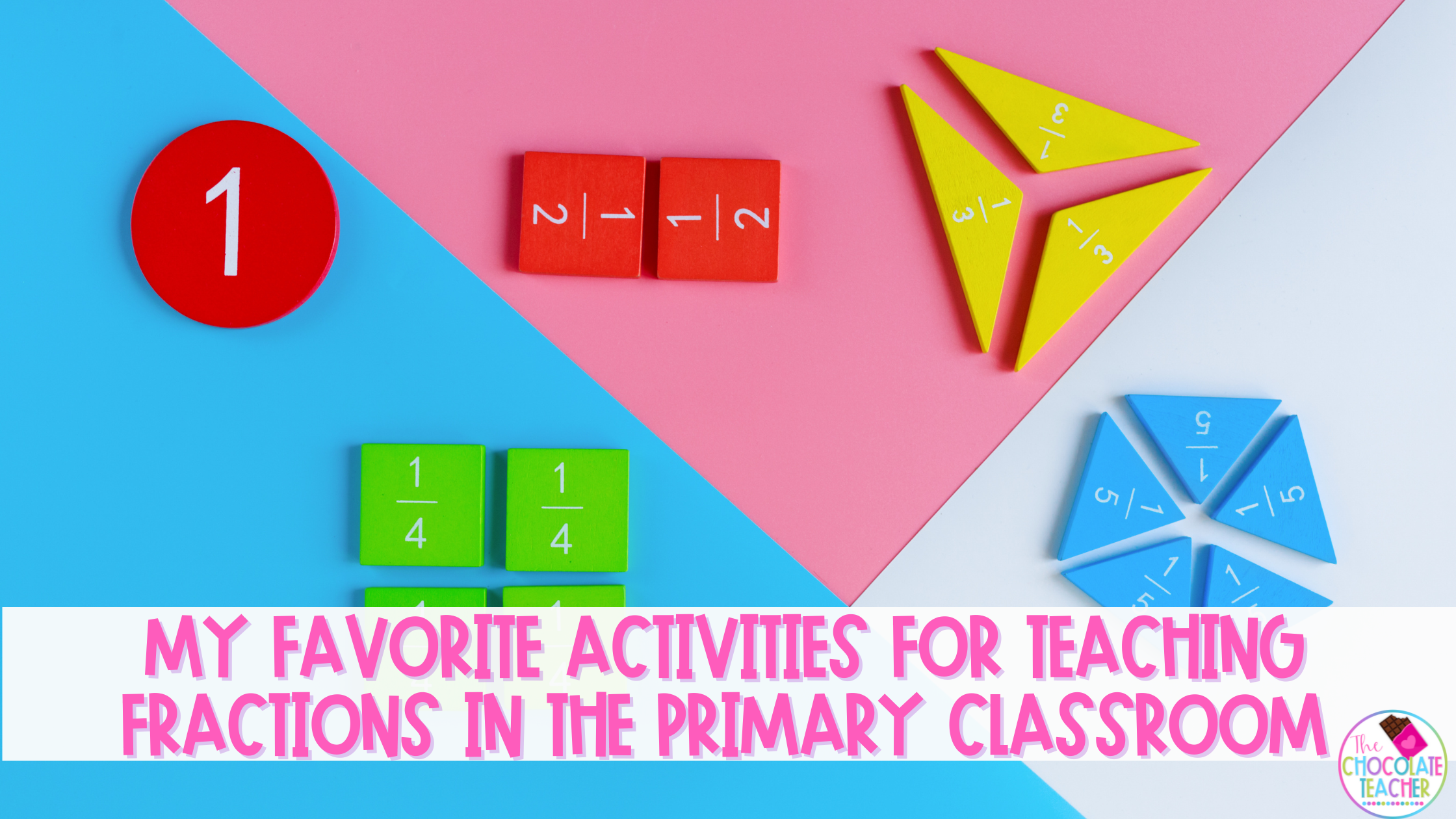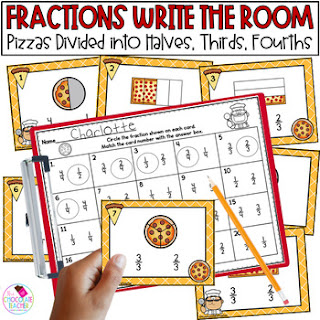Teaching fractions is one of my favorite math concepts to teach. But fractions are not always the easiest concept for students to pick up. Students in the primary grades are just starting to wrap their heads around what numbers mean and how they relate to one another. Then we have to introduce parts of a whole and fractions. But with some strategic planning we can help give our students a solid foundation with fractions for their future teachers to build upon. Today I'm excited to share with you some of my favorite activities for teaching fractions.
My Approach to Teaching Fractions
While looking at fractions as a big picture topic can be intimidating, fractions become much easier to teach and learn if you start small and break them into steps that your students can understand. I've found this is most beneficial by using several different approaches.
1. Use Visuals
When I teach fractions, I always start with visuals. Providing pictures, charts, and images for the concepts that you are teaching makes it much easier for your students to understand the new information. While this is useful in everything we teach, it is especially helpful in math where the concepts are so abstract. Pictures and visuals help the abstract concepts become more concrete. And . . . using real-life objects, if you can, gives students something familiar to connect with. For fractions, it's really fun to use food like pizza, pie, and apples to demonstrate fractions.
At the beginning of your unit, you will want to start by introducing vocabulary words such as part, whole, numerator, and denominator. It's also important to teach students the names of different fractions like one-half, one-third, and one-fourth. I love to hang posters for each vocabulary word with the definition and a picture in the front of my classroom. These posters serve as a great visual for the kids to refer to throughout the unit or even the entire school year.
If you use a math notebook in your classroom you can copy the vocabulary posters in a smaller size (I like 4 pages in one) and have students glue them into their notebook. You can also have students make their own vocabulary entries.
I like to have students make a vocabulary four square. Simply draw lines down the center vertically and horizontally on the page. Then in each of the four squares students will work with the vocabulary word in a different way. Here's what I have students put in each square: the word, a definition, an illustration (like this pizza cut into four equal parts), and then use the vocabulary word in a sentence. My students always enjoy this activity and it helps to reinforce the new words they are learning.
I've also found over the years that there is no need to water-down the vocabulary. Our students may be young, but when presented with vocabulary they are eager to learn. Make sure to connect a visual example or a hands-on example to help students understand the meaning and then watch out. It's great to walk around the room and hear students using words like 'denominator' in the proper way. Just give them opportunities to learn and practice. Don't forget to model using those words too!
2. Get Hands-on With Games
Who doesn't love a good game? They are always a hit in the classroom, and there is just something about that hands-on approach that engages students at a higher level. Games also reinforce the visual aspect of teaching fractions while breaking it down into something more simple and fun.
Note: Since we don't teach mixed numbers or fractions that make up more than one whole in first grade, I have my students always put the largest number on the bottom and the smallest number on the top. This also gives them extra reinforcement for comparing numbers. That's a two-in-one!
I've also created some fun fraction games for my students to use. Since I know games are always a popular choice during centers and small group instruction, it is a great way to engage students in learning.
My students love playing the games Fraction Fun and Fraction Four in a Row. These are just a couple of the games we use in my classroom to work on identifying a fraction and matching it to a visual representation.
As students play the games, I encourage students to say the fraction when they spin so they get practice using the vocabulary.
3. Practice Makes Perfect
As with everything else, practice is the key to mastering fractions. There's a good reason why a good lesson progresses from modeling to guided practice to independent practice. It's because practice is what helps new skills and concepts make their way from short-term memory to long-term memory.
Practicing the skill in new and exciting ways will keep your students interested and allow their knowledge to expand. It is always fun to mix in a few different no-prep worksheets and activities during your teaching fractions unit.
Activities such as coloring fractions, cutting and pasting equal fractions, and exploring halves, thirds, and fourths are great ways to keep your students actively engaged with making sure the skills and standards are being taught.
4. Engage with Technology
I don't think there are any doubts that using technology is a great way to engage students in learning activities. In order to give my students additional opportunities to practice with fractions, I created these Boom Card activities. Students are guided through the entire fraction learning process from identifying equal and unequal parts to naming the fraction (and everything in between)!
I love adding these digital learning activities to our math centers. Not only do students get great fraction practice, but they also get some technology skills while working on a tablet or computer.
5. Encourage Independence with Write the Room
Finally, I love to wrap up our fraction lessons with a Write the Room activity. If you've been around here a while, you likely already know how much I love write the room! It's such a great way to encourage independence in a vareity of skills. Not to mention, it really saves the day if your kiddos are a bit restless and need to get up and move!
This pizza-themed write-the-room resource is the perfect way to continue practicing fractions in your classroom. Each fraction is displayed in pizza shapes on the task cards. They are displayed in both a circular pizza and a rectangular pizza shape for halves, thirds, and fourths. Students will walk around the room and solve each task card, and then write their answers down on the recording sheet.
You can also play this as a scoot game with the whole room together, or set it up as a math center that doesn't require traveling around the room. There are four different recording sheets included, to allow for simple differentiation.
Make Fractions Fun
Over the years, I've found that this combination of using vocabulary activities, games, worksheets, digital activities, and write the room is such a great way to master fractions. The variety of activities means there's something that will appeal to all of my different learners, and keep things interesting as well.
These resources are perfect for guided practice, independent practice, math centers, and small group instruction. When your students are done they will have a great fraction foundation. If you're looking to streamline your teaching and have fun with fractions, you can find all of these resources in my Teachers Pay Teachers store!
Save these Ideas for Teaching Fractions
Pin this to your favorite classroom Pinterest board so you can come back when you need more classroom ideas for teaching fractions, other math concepts and so much more.



.png)
.png)
.png)
.png)
.png)
.png)








0 Comments